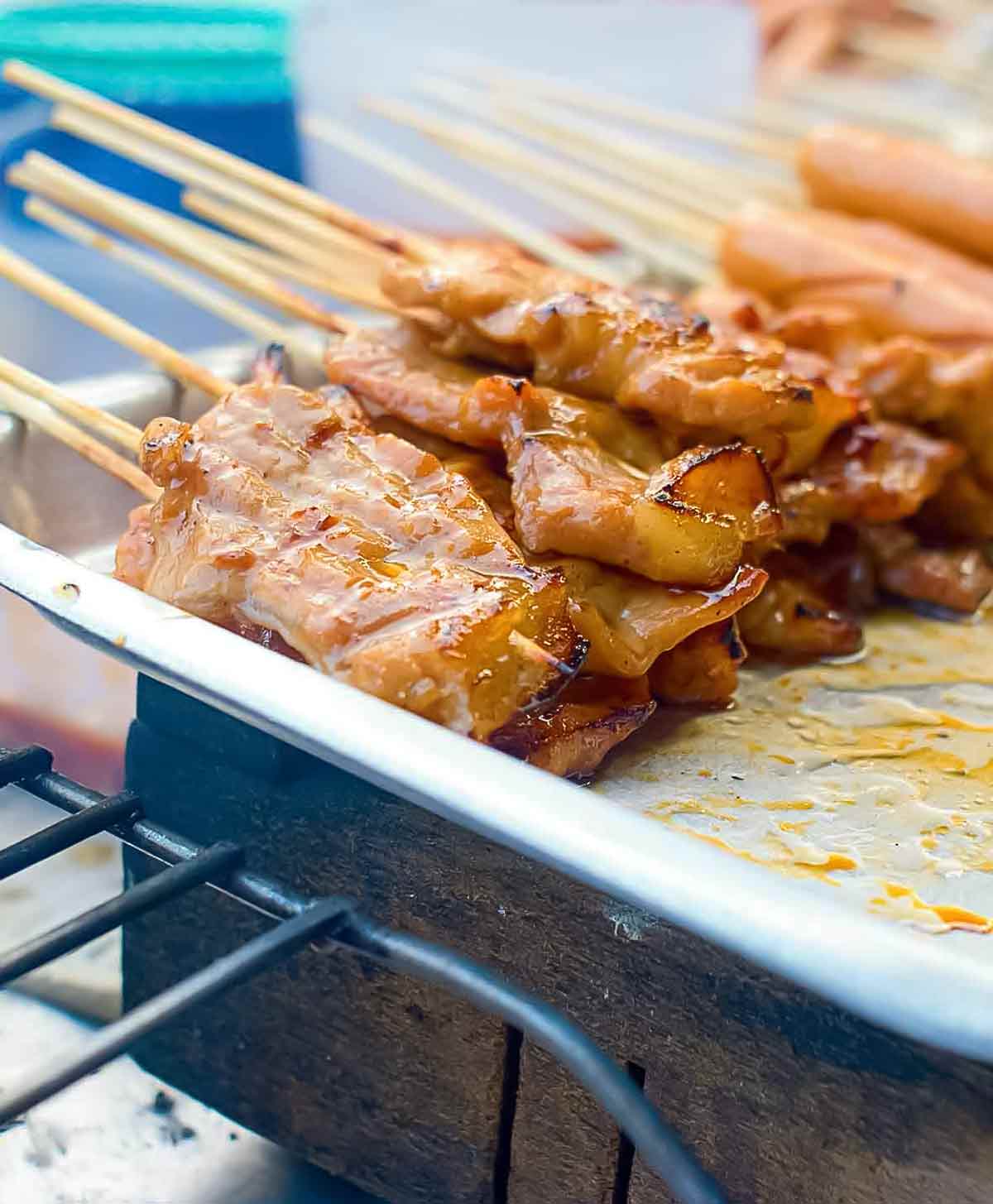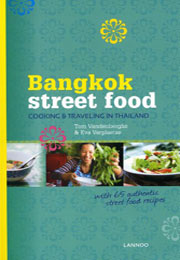
Want to Save This?
These Thai grilled pork skewers, commonly experienced as street food in Thailand under the name moo yang or moo ping, are slightly salty and sweet and soulful. It’s the marinade, made with coconut cream, fish sauce, and cilantro, that works its considerable and haunting magic.–David Leite

Thai-Style Grilled Pork Skewers | Moo Yang
Equipment
- 10 skewers (metal, wooden, or bamboo)
Ingredients
- 2 garlic cloves, finely chopped
- 6 cilantro roots* or a small handful cilantro stems, finely chopped
- 1 1/2 teaspoons freshly ground white pepper
- 4 tablespoons fish sauce
- 1 tablespoon light soy sauce, (we mean “light” as in not a dark soy sauce you find at Asian markets although low-sodium would also work)
- 4 ounces (1/2 cup) canned coconut cream
- 1 tablespoon mild vegetable oil
- 1 tablespoon superfine sugar, (or just blitz granulated sugar in a blender until finely ground but not powdery)
- 1 pound pork tenderloin or loin, thinly sliced at an angle into strips
Instructions
- If using wooden or bamboo skewers, soak them in water for at least 1 hour to prevent them from burning.
- Meanwhile, combine all the ingredients but the pork in a large bowl and mix well. Add the pork and marinate for at least half an hour.
- Fire up the grill (preferably a charcoal one) and let it settle on medium or medium-high flames.
- Weave the strips of pork onto the skewers, allowing as much of the marinade to cling to the pork as you desire. Grill, turning a few times, until the pork is cooked through, 5 to 8 minutes.
- Serve the grilled pork skewers immediately.
Notes
What is cilantro root?
The author of the lavishly photographed and terrifically well-researched book Bangkok Street Food, Tom Vandenberghe, explains that cilantro root is relied on quite often in Thai cooking. It’s just a little less assertive in flavor than the cilantro leaves you’re accustomed to using. If you can’t get your hands on them at an Asian market, maybe you dig up one of your cilantro plants from the garden or make a trip to your local nursery and buy a plant specifically to be sacrificed for this recipe. Then just wash, scrape, and finely chop it, he explains. And if you can’t find cilantro root, no worries, use cilantro stems instead. It won’t be exactly the same thing, but it’s the next best option. Either roots or stems work to a fare-thee-well in this recipe, in which the cilantro presence is a subtle, intriguing hint rather than a whack-you-in-the-face-like-a-baseball-bat hit. There. A little cilantro root competency for you.
Nutrition
Nutrition information is automatically calculated, so should only be used as an approximation.
Recipe Testers’ Reviews
We loved this salty and sweet barbecued pork! The creamy marinade clung to the meat during grilling, so even when you don’t have a lot of time for marinating, you get to enjoy all the flavor the fragrant sauce has to offer.
The marinade for this pork is sublime. It contains garlic, cilantro, pepper, fish sauce, soy sauce, coconut cream, oil, and a touch of sugar. That’s it! Sounds great, doesn’t it? Trying these for the first time was one of those closing-my-eyes-in-pure-joy moments.
This dish comes together quickly and is full of flavor. If you can find cilantro root, it’s definitely worth seeking out. The flavor of the root is much milder than that of cilantro stems. The coconut cream lends a richness to the pork while the soy and fish sauces make it savory. Marinating the pork for at least the recommended time makes all the difference—the longer, the better.
Winner, Winner, pork dinner! Did this for the family BBQ today and everyone loved it.
Don’t be fooled by the smell of the marinade! I must admit that I was worried, as the mixture certainly did not have the most appealing aroma. The end result, though, was absolutely fantastic. The pork was juicy and creamy, tasty yet not overpowering, and the aroma was actually quite nice too.
Wonderful and easy. Kind of salty from the fish sauce, but I love it that way. Grilled up in just a few minutes. I used pork tenderloin, thinly sliced at an angle, and cilantro stems instead of roots.
Amazing how a few simple ingredients can make such a big impact. This was easy to make. I used a 1-pound pork loin and sliced it thin. Marinated it for over an hour and grilled on a charcoal grill at medium heat for about 8 minutes. It was moist and flavorful. Great as an appetizer or part of a main meal. This is going to be a staple recipe in our family.
What a great recipe for the grill. We had a fantastic time skewering up the meat. There was much anticipation as we sat next to the barbeque taking in the aroma of the pork as it cooked. The flavor didn’t disappoint. Everyone at the table had seconds, some had thirds.
This was easy to make and the results were delicious. It makes a great, quick, midweek meal.
These pork skewers were easy to make and took very little hands-on time. I cheated just little and pulsed the marinade ingredients in the blender, which made it even easier.
I made this last week and it was great! I used pork tenderloin and cilantro because I didn’t have time to go get cilantro root. This reminded me a lot of the Vietnamese version (Thit Nuong), which usually has finely chopped lemongrass, but this had the addition of cream of coconut, which added a great flavor.
The meat was so juicy and tender and even my picky eaters had seconds.


















This is Moo Ping. Moo Yang is the grilled and sliced one you speak of at the end.
Seattle2k, I spoke with Pim Techamuanvivit, executive chef at Nahm Restaurant, The Metropolitan, in Bangkok. She said, “Moo yang is a cooking technique. Moo = pork and yang = grilled. Moo yang is simply grilled pork. It can be flavored with anything or served with anything.
“Moo ping is a particular dish. When you say moo ping, you’re really referring to pork that is always boneless, always on skewers, and always marinaded in a sweetish marinade (which sometimes has sweetened condensed milk in it). It’s served fresh off the grill, on sticks, and often with sticky rice and no extra sauce. Usually not a dish you get in restaurants but from food stalls.”
So, Seattle2k thank you.
Hello Seattle2K, yes, I agree that skewered smaller pieces of pork that are grilled are most commonly referred to as Moo Ping. Moo (Pork) Yang is usually what Thais say about larger pieces of pork. However, the English transliteration “Yang” does translate as “grilled” and hence not entirely inaccurate. Another reference point is Gai Yang–or “Grilled” Chicken of Issan, where the famous Thai Sweet Chili Sauce comes from “Nahm Jjim Gai”. I hesitantly use the word grilled since its usually roasted close to a fire, not on metal grates that most non-Asian would say is real grilling. The chicken is sometimes mounted in bamboo double-skewer contraptions to hold the 1/4, 1/2, or shoer chicken flat to cook over the charcoal. Any of the above can be Aroy maak. (very delicious). Have fun cooking folks and take a journey to Thailand to get a real taste of either Moo Ping or Moo Yang!
Thanks for that, Robert!!
This is my favorite way to cook. All the prep can be done first thing in the morning and left to marinate. When dinnertime rolls around, it requires only a quick grilling. I served this with a warm cabbage salad and a side of coconut rice. Beautiful bold complex flavors for so little effort.
Always a relief when quick is still satiating, yes?! Love these skewers and so happy that they’re now a staple for you as well, Beth.